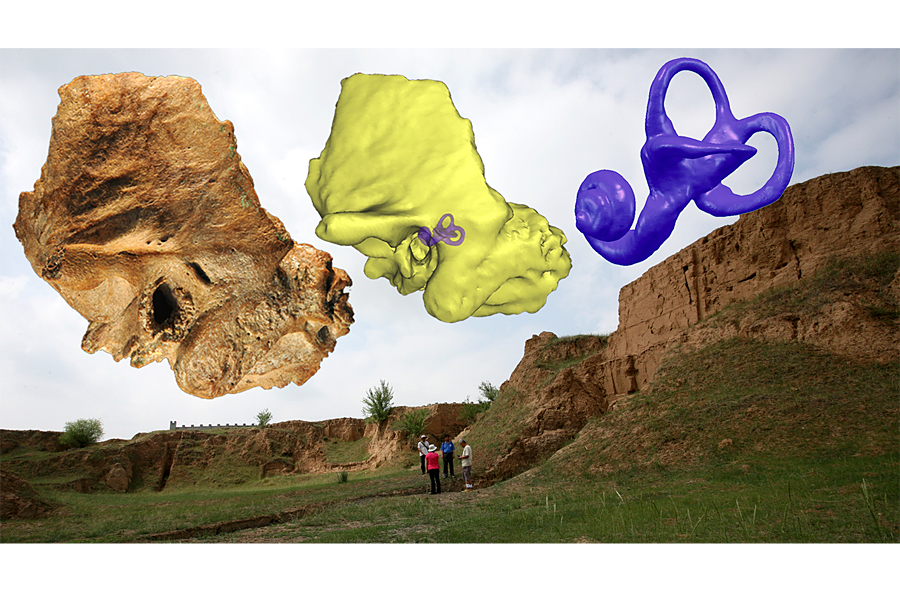Neanderthal ear turns up in unexpected place, muddling evolutionary picture
Loading...
When anthropologists took a second look at a partial skull of a 100,000-year-old human unearthed in Northern China, they found something that complicates our understanding of how modern humans came to be.
The specimen's inner ear, a pair of bony mazes embedded in either side of the skull that helps humans keep their balance, appeared to belong to a Neanderthal, a species that lived in Europe from about 200,000 years ago to about 30,000 years ago. But the rest of the skull looked completely different.
Anthropologists say the presence of this distinct ear in another early human suggests a more dynamic, interactive exchange between early human populations than commonly thought.
In a study published this week in the Proceedings of the National Academy of Sciences, the researchers posit that the Chinese inner ear is a result of breeding among different communities of early humans.
The remains belonged to a member of the genus Homo – a group that includes both Neanderthals and modern humans – but the study's authors have not specified the species, except to say that it could not have been a Neanderthal that had somehow wandered into China.
The inner ear was part of a complete temporal bone found in the 1970s in Xujiayao, a village in Shanxi Province, China. This bone displays the entire ear region, the lower side of the braincase, and the jaw joint.
Had this specimen been entirely Neanderthal, the braincase and jaw joint would have been shaped more distinctly like those of Neanderthals found in Europe. So the Xujiayao specimen was something of a pastiche, sharing characteristics of different early human species, say researchers.
"Evolution was very much mosaic. To the extent that this might indicate population contact, it emphasizes that human populations were very dynamic on this landscape," says study coauthor Erik Trinkaus, an anthropology professor at Washington University in St. Louis.
This specimen could have been a descendant of both a Neanderthal and a member of another early human species.
"There weren't a lot of people around, they didn't have a lot of mate choice and…you know…whatever," says Dr. Trinkaus. "Populations flux back and forth. They mix, they separate, etcetera."
Trinkaus points out that there was dramatic climate change during the time period when the Neanderthals and the Xujiayao specimen lived. As the ice age deepened, people would have been forced to migrate into smaller areas of land. There they would have mixed with different populations. When the ice melted, humans would spread out again.
The inner ear contains semicircular canals that provide a crucial sense of balance. Without this part of the ear, humans would be unable to stand upright. "They're a core part of our existence," says Trinkaus. In Neanderthals, the shape and proportion of these semicircles are distinct from those of other humans.
Trinkaus and his colleagues explored different possible ways the Neanderthal canals could be related to balance in their paper. They compare other physiological features that could be related to balance between Neanderthals and other humans. But they found no connection.
"For example, Neandertals have low skulls with big faces," says Trinkaus. "Well, earlier humans have even lower skulls with even bigger faces and yet they don't have this configuration." Thus the skull and inner ear characteristics could not have been intrinsically linked in their function.
The researchers didn't want to ruin the whole temporal bone, but they needed to separate the semicircular canal from the rest of the specimen. So Trinkaus' colleagues at the Chinese Academy of Sciences in Beijing used technology. They scanned the bone using a three-dimensional X-ray system. Then they could extract the inner ear from the rest of the bone virtually.
In order to compare ear canals thoroughly, the researchers used the same method on other subjects. They studied the inner ear of other early human fossils in China as well as modern human subjects. Then the data was set against existing Neanderthal literature and published information on early modern humans.
"We tend to draw these very simple diagrams of how human evolution took place and they probably have very little reality," says Trinkaus. With the shifting and intermingling populations, it's "total chaos."
In order to describe human evolution, Trinkaus says, "We need much more complicated, much more sophisticated, and much more multifactorial models."








